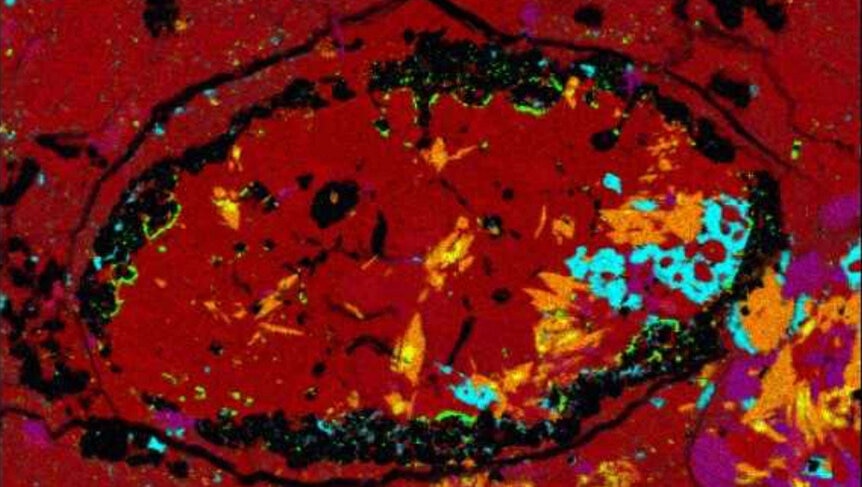Create a free profile to get unlimited access to exclusive videos, sweepstakes, and more!
What's the deal with that ginormous asteroid that threw a rock at Earth?

Things from space get thrown at Earth all the time—asteroids, meteorites, junk metal from dead satellites—but there is something about one space rock that could tell us more about the dawn of the solar system.
Back in 2008, a meteorite later named Almahata Sitta (AhS) crash-landed in Sudan. Now scientists have taken another look at this meteorite and believe it was part of a monster 9-ton meteor that exploded into 600 pieces in the atmosphere, and that meteor was probably hurled over here by an even more enormous asteroid. It’s almost as if it flung a piece of the nascent solar system right at our planet. Its mineral makeup is revealing things about minerals that have never before been found in carbonaceous chondrites. Meaning, it could get us that much closer about finding out how water came to Earth.
"I think findings like ours are the unexpected results," Vicky Hamilton, who led a study recently published in Nature Astronomy, told SYFY WIRE. "Meteorites containing water-bearing minerals are indirect evidence of the delivery of water to early Earth, as we don’t have any knowledge of exactly what kinds of asteroidal material impacted the planet. Our discovery of a previously unknown, large, water-rich asteroidal parent body (that no longer exists) means that it’s possible even more water was available to be delivered to Earth, especially if there were other asteroids like it."
This piece of Alhama Sitta is identified by Hamilton's team as Alhama Sitta 202, since it is only one of many types of meteorite crammed together in Alhama Sitta.
Metamorphic rocks like asteroids and meteorites are transformed by different natural forces, and those that start to morph at low temperatures are usually made up of many hydrous, or water-bearing, minerals. Hydrous metamorphism is rare in meteorites that have reached Earth. In rocks that start to change at higher temperatures, hydrous minerals become more reactive or break down. The shard of AhS that studied under an infrared microscope showed properties of hydrous metamorphism. AhS is a carbonaceous chondrite, a stony meteor containing carbon compounds and flecked with chondrules, or spherical-ish pieces of minerals. Some of these carbon compounds are organics that may or may not have been the spaceborne ingredients for life on Earth.
Carbonaceous chondrites are also thought to be one source of the water that made it over here when things were smashing into each other in the chaos that was the early solar system 4.6 billion years ago. So are comets, basically huge balls of ice shooting through the void.
"Minerals differ in the their chemistry and/or their arrangement of component atoms," Hamilton said. "As such, they have unique spectral signatures in the infrared, and that is what allowed us to identify the presence of amphibole in the meteorite."
Asteroids, and the disembodied pieces of them that end up being meteors and meteorites, are thought to be debris from the birth of the solar system. Most of them float around in the asteroid belt between Mars and Jupiter. Because Mars is a barren wasteland that is not covered in grass or forests or cities like Earth is, you can see the beating it’s taken from these rogue rocks. Craters are just harder to find on Earth because many of them were buried over billions of years. There has still been no shortage of meteorites, but there is something that makes AhS stand out from all those you see in museums or on eBay (that really is a thing).
Embedded in AhS are amphiboles, which are rare in carbonaceous chondrites. These are hydrous minerals whose presence probably means that whatever it broke off of was a rock that contained water and went through a long, excruciating metamorphosis. There has only ever been one other meteorite in which traces of amphiboles were identified, and that was Allende, whose chemical makeup indicates that it came from a different object than AhS. The mystery rock that threw AhS at Earth could have been anywhere from 400 to 1,100 miles in diameter. That is about the size of the dwarf planet Ceres, and Ceres alone equals most all the mass in the asteroid belt.
"When we find things like AhS 202 that tell us there were once other similarly large bodies that are now gone, that is unexpected," said Hamilton. "It is also unexpected because the carbonaceous chondrite meteorites we have been studying for decades have all been assumed to come from bodies around 62 miles in diameter, so that tells us our collections are not complete."
Because AhS is more proof of a different formation process than most known meteorites have gone through, it suggests that this process might have been more common in the early solar system than we think, though we are still in the dark as to how common it actually was. Samples from Ryugu and Bennu might offer more insight on that. Spectroscopy done by the JAXA’s Hayabusa-2 and NASA’s OSIRIS-REx spacecraft already suggests that both meteorites could be carbonaceous chondrites that went through hydrous metamorphism. Hamilton does believe that the recently explored Bennu and Ryugu are also types of carbonaceous chondrites.
"While we do not think that Bennu or Ryugu are made of the same material as Almahata Sitta 202, all three have compositions consistent with carbonaceous chondrite meteorites," she said. There is evidence from OSIRIS-REx and Hayabysa2 that the compositions of Bennu and Ryugu are dissimilar from known meteorites, so in that respect, all three may tell us more about the early solar system than the current meteorite collections can."
This might be the one time that we might want the asteroid AhS came from to throw us another meteorite.



























